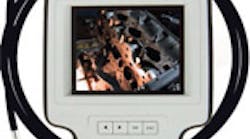Inspection means more than a caliper and a bright light. Recently, a company called Aven Inc. introduced a borescope that feeds live images to a wide-view color LCD display. For quality control technicians used to relying on an eyepiece, it means an expanded range of capability to recognize, record, and share still or video images of narrow cavities or small details on castings, especially in areas that are difficult to view with standard inspection tools.
The rising level of sophistication in inspection equipment for castings is not surprising: the advances in information technology for coordinating data; in imaging technology for locating and capturing product conditions; and in networking technology for relaying the information from remote locations — all have coincided with the advances in product quality standards, and in metalcasters’ cost-saving initiatives, to supply an increasing demand among for inspection devices.
“This professional system packs a lot of features into your palm,” stated Aven president Mike Shahpurwala, of the new borescope. Aven supplies precision optical equipment worldwide. “It’s light, powerful, and eliminates the need for a separate monitor or camera.”
The cordless system is a self-contained instrument that combines a 3.5-in screen and SD card for image capture. It is lightweight (9 oz., or 260 g) and measures with four white LED lights packed in a 3-ft., flexible, and watertight cable that will not overheat.
It incorporates two of the critical design factors for advanced “monitor image guide (MIG)” borescopes: integrated components, so there’s no need for a separate camera and viewing device; and built-in memory card and USB vide output that streamline reporting for customer reviews, regulatory compliance, and other reporting needs.
Flexible borescopes
Generally, borescopes are characterized as “rigid” and “flexible,” and while most suppliers offer models of both types, developers of each style claim particular advantages for their offerings. Both designs are essential for non-destructive testing, which is increasingly necessary to provide product quality control for most cast products used in critical manufacturing applications. This includes aerospace, automotive, construction, defense, medical equipment, and other types of equipment.
The Aven product described above is an example of a flexible borescope, which allow a technician to probe internal chambers of complex castings, but these devices are useful for on-site inspection and thus for maintenance and predictive maintenance tasks, too.
One of the most widely distributed product lines is Gradient Lens Corp.’s (www.gradientlens.com) Hawkeye Precision Borescopes line, for internal inspection of parts with small openings that cannot be seen with the human eye, like the interiors of fuel injector nozzles, engine blocks, transfer cases, brake manifolds, hydraulic assemblies, or valve seats. Hawkeye products are marketed for their image quality, ruggedness, and portability. For example, the new MicroSlim series is capable of fast and reliable, precision inspection of openings as narrow as 0.073 in. diameter.
This relatively new class of “micro borescopes” have been developed for interior inspections of diameters of 3.0 mm (0.12 in) and smaller; castings are a particularly common and necessary application for these devices.
Metalcasters using a micro borescopes need to verify the condition of interior channels and cavities, where they must locate burrs, excess material, or sand blockages left over from the shakeout process. Rigid micro borescope maybe used to inspect in areas where there is straight access available, but when the inspection demands a view deep into an interior cavity, around corners or through channels, a flexible micro borescope is the solution.
Some operations may use both rigid and flexible borescopes to inspect castings, such as high-performance engines, where different types of defects may result from different aspects of the production process, e.g., metallurgical defects or solidification problems.
Rigid borescopes
However, by comparison to the flexible designs, rigid borescopes are usually conceded by manufacturers to offer better resolution, brighter images, and more durability than flexible borescopes. They are generally less expensive, too.
General Electric’s GE Sensing and Inspection Technologies subsidiary offers a line of rigid borescopes with sold metal construction and a triple-tube shaft design meant to withstand the heat, humidity, and dusty atmospheres of manufacturing operations, like metalcasting plants. The GE series includes rotary scan units, swing prism devices, and “mini rigid” designs.
Rotary scan borescopes allow 360º circumferential viewing without moving the body of the scope. GE has various models available for use according to the directions- of-view and fields-of-view. Swing prism borescopes allow the inspector’s direction-of-view to be adjusted from 55º to 115º, for a panoramic viewing of a casting that might otherwise require two or three conventional borescopes to inspect it. The GE Mini Rigid design is a patented rod-lens optical system that promises image clarity and brightness, as well as bending tolerance.
GE also offers a line of accessories like eyepiece adapters, video borescope adapters, monitors, recording devices, light guides, and light sources that are meant to expand the versatility and performance capabilities of its rigid borescopes.
The range of design options and performance capability for borescopes continues to expand, and as the devices become more common the standard functions become more affordable. Thus, the transition from laboratory or benchtop use will continue to accelerate, and metalcasters will be able to use them to speed up product inspection and quality control.











